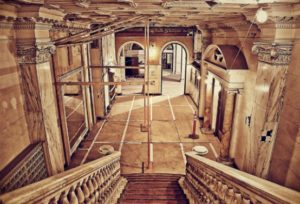By Bobbi Pinkert, Class of 1999
Co-Tour Director Hotel Boom

“No one ever sets out to build an historic building”, states Paul Alessandro, partner at Hartshorne Plunkard, the restoration architect of both the Chicago Motor Club/Hampton Inn and the Chicago Athletic Association Hotel. “He or she is building a modern building for that time and place.”
Discovering the motivations of the architect of an existing building takes a monumental amount of research. “These buildings are not dusty old history,” Alessandro’s says. His goal is to discover, “what was the original thought of the building, what was inventive? That’s what we want to preserve.” The research includes studying the life of the architect, his or her other buildings, the architectural fashions of the time, the scope of technology, and “literally, the nuts and bolts” used to put it together.

Next, Alessandro takes time to experience the actual space, “what is it trying to say, what about it is unique, exciting. What will we be building off of? We don’t just ‘look at it’, it’s not a museum. We have to bring it into the modern era, but we don’t want to just make a copy or a pastiche. It’s kind of like improv. We’re taking what’s there and doing a riff on it.”
Restoration begins with an inventory of what exists and what has been removed. At the Chicago Motor Club, for example, Alessandro found a treasure trove of pieces that had been removed over the years and carefully stored, including most of the lighting and a piece of the mural. During the preliminary inventory, the original floor was uncovered. “We had to reproduce the Trip Tix counter and create a way to tie it into the concierge desk and the bar, as well as re-creating the back office,” he adds.

Bringing the John Warner Norton mural back to life required building a protective room with controlled heat and humidity. Once the mural was glued back together, Alessandro looked at the entire mural: “it just didn’t make any sense”, stated the architect. “It had been painted over so many times. When we finally got down to the correct colors, it looked sharper and brighter than even before we fixed it.”
The Chicago Athletic Association Hotel was a much bigger project and required a lot more digging. “It had been remodeled and redone many times. We had to peel stuff away, insert a hotel and public spaces into the mix, and we had a lot of structural issues.”
The mosaic floor in the entrance space had missing pieces and was buckling. Every piece of marble, plaster, mahogany paneling, and bas-relief had to be replaced or repaired or restored, using the same materials, to its original condition. This enabled the architect and the developers to call it “museum quality”, which won the building the 2016 AIA Crombie Taylor Award for Preservation.
Luckily, according to Alessandro, “there are wonderful craftsmen in Chicago. One of the marble workers was a 40-year-old immigrant who cleaned, polished, and re-glued every piece of marble. He almost cried when the project was finished, saying he was so happy he ‘could actually do my craft.’”
While cleaning the exterior of the building, the workmen discovered a mason had carved his name into the masonry. “These buildings are time capsules where some craftsman cared enough, did everything by hand, and took great pride,” he adds
With all the work completed and both projects getting kudos from visitors, what does Alessandro consider the best and worst part of these projects? “The end”, he responded.





Great article Bobbi, especially “the end”!
Thanks, Bobbi, for making preservation come to life. Fascinating look at these buildings.
Bobbi, thanks for an insightful and interesting article!
Thank you, Bobbi. Interesting to get the architect’s perspective and insights on preservation.
Thank you Bobbi! When I read “the end”, your question and Alessandro’s response brought to mind a James Lipton interview. Thank you also for the great photographs!
Thank you, Bobbi, for exploring the architect’s motivation and methods behind the great restoration work that was done on both of these buildings.